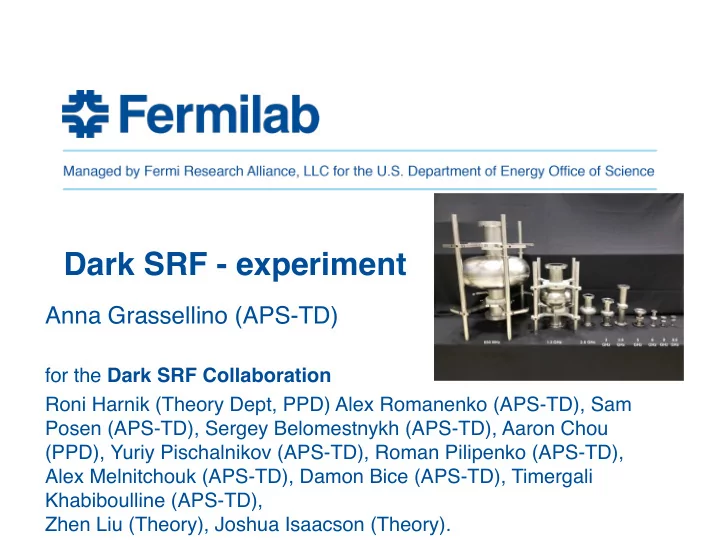

Dark SRF - experiment Anna Grassellino (APS-TD) for the Dark SRF Collaboration Roni Harnik (Theory Dept, PPD) Alex Romanenko (APS-TD), Sam Posen (APS-TD), Sergey Belomestnykh (APS-TD), Aaron Chou (PPD), Yuriy Pischalnikov (APS-TD), Roman Pilipenko (APS-TD), Alex Melnitchouk (APS-TD), Damon Bice (APS-TD), Timergali Khabiboulline (APS-TD), Zhen Liu (Theory), Joshua Isaacson (Theory).
Light Shine through the Wall – with SRF cavities Pictured on the right: Routine cavity test (dozens a week) at the APS-TD SRF Vertical test Facility Takeaway message: The experiment looks a lot like what we already do. We just need to iron out some details. 2 Anna Grassellino - DarkSRF experiment 1/16/19
Two options for where to run the experiment: VTS (T= 1.4K) or Dilution Fridge (T~20 mK) Vertical Dilution cavity Fridge at test APS- TD Facility Quantum at APS- Lab (QCL) TD (VTS) More Ready prep now required T= 1.4K T~20 mK ~1000 NO photons thermal photons 3 Anna Grassellino - DarkSRF experiment 1/16/19
Light Shine through the Wall – for the first time in the world, realized with SRF cavities: VTS frames in fabrication Tuner/piezo Emitter (ON, tunable) Receiver (OFF, fixed) 4 Anna Grassellino - DarkSRF experiment 1/16/19
The enabling part: the extraordinary high Q • SRF cavities (f < 3 GHz) can easily reach Q > 1e9 at T< 2K, vs > 5 orders of magnitude over copper cavities, combining E and R à > 10 order of magnitude gain • Via deep knowledge of intricate niobium cavity surface treatments, the Fermilab SRF group has pushed the boundaries of Q to world records, reaching routinely among the highest quality factors in nature Q > 4e11 • Moreover, we have developed the expertise to manipulate the Q factor in the range from >10 25 photons to the quantum regime (< 20 photons) S. R. Parker et al , Phys. Rev. D 88, 112004 (2013) J. Hartnett et al , Phys. Lett. B 698 (2011) 346 J. Jaeckel and A. Ringwald, Phys. Lett. B 659, 509 (2008) A. Romanenko, S. Posen, and A. Grassellino, “Methods and system for treatment of SRF cavities to minimize TLS losses,” US patent pending, Serial No.: 62/742,328. 5 Anna Grassellino - DarkSRF experiment 1/16/19
New enabling capability: SRF cavities in quantum regime • First measurements in quantum regime demonstrate that high Q SRF cavities already have world-leading sensitivity to dark matter floating around in the galaxy A. Romanenko, R. Pilipenko, S. Zorzetti, D. Frolov, M. Awida, S. Posen, A. Grassellino, arXiv:1810.03703 A. Romanenko and D. I. Schuster, Phys. Rev. Lett. 119 , 264801 (2017) 6 Anna Grassellino - DarkSRF experiment 1/16/19
New challenges ahead: the “frequency precision” frontier Emitter: Receiver: > 30 MV/m (> 10 25 photons) 1. T = 1.4K (VTS) ~ 1000 • • OFF photons background Q >10 10 @ 1.3 GHz à Df < 0.1 Hz! Q> 10 10 • • 2. T = 20 mK (Dil Fridge) < Challenge: 0.1 Hz à controlling Measure its frequency cold, • • 10 photons background the cavity wall displacement with then match emitter to it via ~sub-nanometer precision tuner/piezo mechanism • Compensate in real time for He • Challenge: design/realize as vibrations or other sources stiff as possible cage to keep f stable to sub-Hz level Stimulated emission: frequencies need to match! 7 Anna Grassellino - DarkSRF experiment 1/16/19
Enabling tool: Tuner and Piezo (courtesy of Y. Pischalnikov and group) SRF Cavity Tuner (LCLS II double lever tuner) to tune “transmitter” cavity Coarse Tuner Piezo-actuator for fine/fast tuning - Range up to D X=2mm or D F=5MHz - Resolution d x=5nm or d F=12Hz - Hysteresis ~ 300Hz Fine/Fast Tuner Stepper motor for coarse/slow tuning - Range up to D X=3um or D F=8kHz - Resolution d x=0.05nm or d F=0.1Hz (*) (*) Piezo tuner (resolution will be limited by resolution electrical noise of the piezo measured amplifier) with LCLS II cavity ~0.15Hz was limited by noise at HTS 8 Anna Grassellino - DarkSRF experiment 1/16/19
Axion Searches – concept under development Multimode • Axion detection typically bets on excitation increasing B fields, with lower Q gives non zero cavities (copper cavities) E.B in the cavity • If however we bet on Q, with lower B field (compatible with SRF cavities, up to ~200 mT), we can gain orders of magnitude in sensitivity 1.66 GHz B field 1.3 GHz E field • Two options: – Stimulated emission (multimode scheme or guide static B field in Beampipe coils to guide static B field in the receiver) cavity parallel to beam – Scan, but will require multiple axis and E RF field ? frequency tunable cavities (can be developed, e.g. use in house cavities in range 650 MHz-9 GHz with Nb plunger) 1/16/19 9 Anna Grassellino - DarkSRF experiment
Conclusions • Dark SRF experiment looking for dark photons is low hanging fruit, given the unique and world leading Fermilab SRF capabilities • Will either discover or move exclusion boundary for dark photons existence by orders of magnitude compared to the state of the art • World leading expertise in high Q SRF cavities is now further enhanced by the new quantum R&D activities • Straightforward upgrade path: running in the dilution fridge • Next: extend search to axions • Upgrade path will bring enhanced and unprecedented sensitivity, but will require additional resources (technical and equipment) 10 Anna Grassellino - DarkSRF experiment 1/16/19
Acknowledgements • The awesome Dark SRF Group (group picture below) 11 Anna Grassellino - DarkSRF experiment 1/16/19
Recommend
More recommend